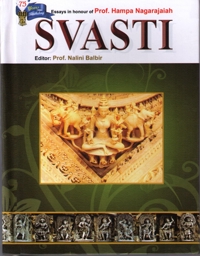We are all delighted to present this volume of essays to Prof. Hampa Nagarajaiah alias “Haṃpanā”, a star of learning and culture, a bright, lively and enthusiastic personality whose contribution to Karnatak culture and the Jain traditions are so numerous and valuable. Who would not be impressed by his list of publications and the wealth of information they bring to light?
Prof. Nagarajaiah was born on 7th October 1936 in the village of Hampasandra (Cikkaballapur District, Karnataka). After obtaining his M.A. degree in 1959 from Mysore University with specialization in Literature, Poetics, Linguistics, Old Kannada Texts, he got his PhD from Bangalore University for A Comprehensive study of Vaḍḍārādhane. He first served as Lecturer in Kannada in Government Colleges (1959-1969). He then joined Bangalore University in 1970, where he was Lecturer, Reader and Professor until retirement in 1997.
Haṃpanā is a true persona whose manifold activity has extended to all fields. Far from being a scholar living in his ivory tower and content with his own research, he is present in a large number of institutions - too many to be mentioned here. The Kannada Sahitya Parishat, Bangalore, had him as Secretary (1966-1974) then as President (1978-86). He was the Director of the Jaina Research Centre, Bangalore (1977-79), the Director of the Institute of Kannada Studies, Bangalore University (1992-94), the Director of Kannada & Culture, Governement of Karnataka (1992) and the Director of the Jaina Research Institute, Shravanabelgola (1999-2002). Hence he plays an official role in the diffusion of Indian culture as a whole. One of the main concerns of Haṃpanā is to share his love for Indian culture, especially Kannada and Jain, with everybody who is willing to, and, indeed, many of his numerous books in Kannada, then, more recently, in English, reach large audiences. Haṃpanā is also a writer. One section of his publications consists of books for children. His services in this field, which was rather neglected in India until recently, have been recognized by the “National Award for Extraordinary Service for Children Literature” given to him in 1990 - one award among several that he has received in the course of his long career.
No wonder, then, that scholars from India and abroad responded so enthusiastically to the call of papers for this volume. How could one be reluctant to pay a small tribute of homage and gratitude to a person like Haṃpanā, whose knowledge, enthusiasm, generosity and hospitality are so helpful and comforting? The papers offered here are devoted to a wide range of subjects, a requirement to honour a scholar whose interests have no boundary. They cover all aspects of Jain culture in matters of space, time and sects, ignoring none of the four directions and going beyond the seven oceans, forgetting neither the past nor the present, neither the Digambaras nor the Śvetāmbaras nor the Terāpanthins. Sanskrit, Prakrit, Apabhraṃśa, Kannada, Tamil and Hindi textual sources have been used according to the topics selected. Epigraphy and iconography, two areas where Haṃpanā has published so much, are of course present. Broad perspectives on the impact and relevance of Jainism to modern times are submitted by some of the contributors as thoughts for the future. The increasing interest for the study of “living” Jainism is underlined in the last section of the book. The “trilingual formula” is valid here - as it is India: Kannada and Hindi are the languages of two essays, beside English which is used by most contributors.
Finally, I would like to quote two Sanskrit stanzas which were composed spontaneously by Prof. I. Mahadevan when he received a copy of Jinendra Stavana, one of Haṃpanā’s books. They show how Haṃpanā’s writings are felt as an inexhaustible source of inspiration and a work of dharma, for the benefit of all:
Jinendrastavanaṃ stotraṃ śilāsu likhitaṃ purā /
ācārya-Nāgarājena punar eva prakāśitam //
śrāvakādhyayanārthaṃ ca Jinadharmaṃ prabodhituṃ /
ktaṃ puṇyam idaṃ stotraṃ sarvalokahitāya ca //
जिनेन्द्रस्तवनं स्तोत्रं शिलासु लिखितं पुरा।
आचार्यनागराजेन पुनरेव प्रकाशितम्॥
श्रावकाध्ययनार्थं च जिनधर्मं प्रबोधितुं।
कृतं पुण्यमिदं स्तोत्रं सर्वलोकहिताय च॥
We wish Haṃpanā, and his wife, who is a major writer too, a long and active life in years to come. May we see this great scholar often standing up for an interesting and witty remark in conferences in India or elsewhere! We also seek his blessings in all our endeavours.
SVASTI! SIDDHAM! ŚUBHAṂ BHAVATU! KALYĀṆAM ASTU!
स्वस्ति। सिद्धम्। शुभं भवतु। कल्याणम् अस्तु।
Prof. Dr. Nalini Balbir
University of Paris-3 Sorbonne Nouvelle,
UMR 7528 “Mondes iranien et indien”

